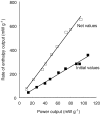Slow skeletal muscles of the mouse have greater initial efficiency than fast muscles but the same net efficiency
- PMID: 15243139
- PMCID: PMC1665130
- DOI: 10.1113/jphysiol.2004.069096
Slow skeletal muscles of the mouse have greater initial efficiency than fast muscles but the same net efficiency
Abstract
The aim of this study was to determine whether the net efficiency of mammalian muscles depends on muscle fibre type. Experiments were performed in vitro (35 degrees C) using bundles of muscle fibres from the slow-twitch soleus and fast-twitch extensor digitorum longus (EDL) muscles of the mouse. The contraction protocol consisted of 10 brief contractions, with a cyclic length change in each contraction cycle. Work output and heat production were measured and enthalpy output (work + heat) was used as the index of energy expenditure. Initial efficiency was defined as the ratio of work output to enthalpy output during the first 1 s of activity. Net efficiency was defined as the ratio of the total work produced in all the contractions to the total, suprabasal enthalpy produced in response to the contraction series, i.e. net efficiency incorporates both initial and recovery metabolism. Initial efficiency was greater in soleus (30 +/- 1%; n=6) than EDL (23 +/- 1%; n=6) but there was no difference in net efficiency between the two muscles (12.6 +/- 0.7% for soleus and 11.7 +/- 0.5% for EDL). Therefore, more recovery heat was produced per unit of initial energy expenditure in soleus than EDL. The calculated efficiency of oxidative phosphorylation was lower in soleus than EDL. The difference in recovery metabolism between soleus and EDL is unlikely to be due to effects of changes in intracellular pH on the enthalpy change associated with PCr hydrolysis. It is suggested that the functionally important specialization of slow-twitch muscle is its low rate of energy use rather than high efficiency.
Figures








Similar articles
-
Efficiency of fast- and slow-twitch muscles of the mouse performing cyclic contractions.J Exp Biol. 1994 Aug;193:65-78. doi: 10.1242/jeb.193.1.65. J Exp Biol. 1994. PMID: 7964400
-
Mechanical efficiency and fatigue of fast and slow muscles of the mouse.J Physiol. 1996 Dec 15;497 ( Pt 3)(Pt 3):781-94. doi: 10.1113/jphysiol.1996.sp021809. J Physiol. 1996. PMID: 9003563 Free PMC article.
-
Is the efficiency of mammalian (mouse) skeletal muscle temperature dependent?J Physiol. 2010 Oct 1;588(Pt 19):3819-31. doi: 10.1113/jphysiol.2010.192799. J Physiol. 2010. PMID: 20679354 Free PMC article.
-
Deficiency of alpha-sarcoglycan differently affects fast- and slow-twitch skeletal muscles.Am J Physiol Regul Integr Comp Physiol. 2005 Nov;289(5):R1328-37. doi: 10.1152/ajpregu.00673.2004. Epub 2005 Jul 7. Am J Physiol Regul Integr Comp Physiol. 2005. PMID: 16002556
-
Thick filament activation is different in fast- and slow-twitch skeletal muscle.J Physiol. 2022 Dec;600(24):5247-5266. doi: 10.1113/JP283574. Epub 2022 Nov 23. J Physiol. 2022. PMID: 36342015 Free PMC article.
Cited by
-
Targeting the Ubiquitin-Proteasome System in Limb-Girdle Muscular Dystrophy With CAPN3 Mutations.Front Cell Dev Biol. 2022 Mar 2;10:822563. doi: 10.3389/fcell.2022.822563. eCollection 2022. Front Cell Dev Biol. 2022. PMID: 35309930 Free PMC article.
-
Indices of electromyographic activity and the "slow" component of oxygen uptake kinetics during high-intensity knee-extension exercise in humans.Eur J Appl Physiol. 2006 Jul;97(4):413-23. doi: 10.1007/s00421-006-0185-x. Epub 2006 May 10. Eur J Appl Physiol. 2006. PMID: 16685552
-
Metabolic Cost of Activation and Mechanical Efficiency of Mouse Soleus Muscle Fiber Bundles During Repetitive Concentric and Eccentric Contractions.Front Physiol. 2019 Jun 21;10:760. doi: 10.3389/fphys.2019.00760. eCollection 2019. Front Physiol. 2019. PMID: 31293438 Free PMC article.
-
The energetic benefits of tendon springs in running: is the reduction of muscle work important?J Exp Biol. 2014 Dec 15;217(Pt 24):4365-71. doi: 10.1242/jeb.112813. Epub 2014 Nov 13. J Exp Biol. 2014. PMID: 25394624 Free PMC article.
-
The Effects of Antioxidants and Pulsed Magnetic Fields on Slow and Fast Skeletal Muscle Atrophy Induced by Streptozotocin: A Preclinical Study.J Diabetes Res. 2023 Nov 13;2023:6657869. doi: 10.1155/2023/6657869. eCollection 2023. J Diabetes Res. 2023. PMID: 38020198 Free PMC article.
References
-
- Ardevol A, Adan C, Remesar X, Fernandez-Lopez JA, Alemany M. Hind leg heat balance in obese Zucker rats during exercise. Pflugers Arch. 1998;435:454–464. - PubMed
-
- Barclay CJ. Efficiency of fast- and slow-twitch muscles of the mouse performing cyclic contractions. J Exp Biol. 1994;193:65–78. - PubMed
-
- Barclay CJ. Models in which many cross-bridges attach simultaneously can explain the filament movement per ATP split during muscle contraction. Int J Biol Macromol. 2003;32:139–147. - PubMed
Publication types
MeSH terms
LinkOut - more resources
Full Text Sources

